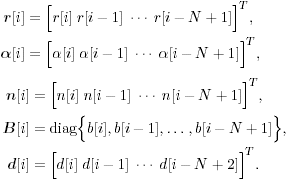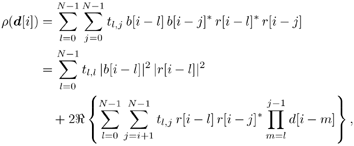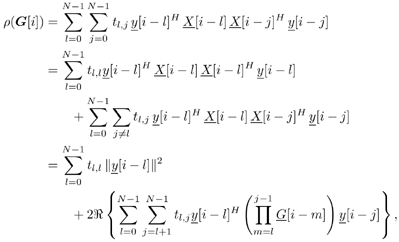9.4 Decision-Feedback Differential Detection in Fading Channels
9.4 Decision-Feedback Differential Detection in Fading Channels9.4.1 Decision-Feedback Differential Detection in Flat-Fading ChannelsThe coherent detection methods discussed in Section 9.3 require explicit or implicit estimation of the fading channel, which in turn requires the transmission of pilot or training symbols. In this section we discuss decision-feedback differential detection in flat-fading channels, which does not require channel estimation. Consider again the signal model (9.19). Assume that the transmitted symbols { b [ i ]} are the outputs of a differential encoder: Equation 9.49 where { d [ i ]} is a sequence of PSK information symbols. In simple differential detection, the complex plane is divided into M disjoint sectors, where M is the size of the PSK signaling alphabet. The detected information symbol Equation 9.50 where r is the correlation coefficient between the fading gains at two consecutive symbol intervals. Multiple-symbol decision-feedback differential detection was developed in [441]. This method makes use of the correlation function of the channel and can significantly reduce the error floor of simple differential detection. In multiple-symbol differential detection [101, 102, 179, 304], an observation interval of length N is introduced. Define the following quantities : Similar to (9.24)-(9.25), we can write the log- likelihood function as Equation 9.51 where Equation 9.52 Equation 9.53 The maximum-likelihood decision metric thus becomes Equation 9.54 Since T -1 is symmetric, so is T . That is, if we denote T = [ t i,j ], then t i,j = t j,i . Hence we can write Equation 9.55 where (9.55) follows from (9.49). In decision-feedback differential detection, the previous information symbols d [ i - 1], d [ i - 2], ..., d [ i - N + 2] in (9.55) are assumed to take values given by the previous decisions (i.e., Equation 9.56 Based on (9.56), we arrive at the following decision rule: Divide the complex plane into M disjoint sectors and determine Equation 9.57 falls. The multiple-symbol decision-feedback differential detection algorithm is summarized as follows. Algorithm 9.2: [Multiple-symbol decision-feedback differential detection] Given the decision memory order N , fading statistics S N , and signal-to-noise ratio E s / s 2 :
The corresponding multiple-symbol decision-feedback differential receiver structure is shown in Fig. 9.1, where the coefficients of the feedback filter are given by the metric coefficients t j = t , j , 1 Figure 9.1. Structure of a multiple-symbol decision-feedback differential detector. Simulation ExamplesFor all simulation results presented below, a differential QPSK constellation is used. The feedback metric coefficients are obtained from the sample autocorrelation of the simulated fading process. Figures 9.2, 9.3, and 9.4 show the BER performance of the decision-feedback differential detector in flat-fading channels with normalized Doppler frequencies B d T equal to 0.003, 0.0075, and 0.01, respectively. It is seen that the error floors of the simple differential detector ( N = 2) are reduced by the decision-feedback differential detector (DF-DD) with N = 3 and N = 4. Figure 9.2. BER performance of a decision-feedback differential detector in a flat-fading channel with B d T = 0.003. Figure 9.3. BER performance of a decision-feedback differential detector in a flat-fading channel with B d T = 0.0075. Figure 9.4. BER performance of a decision-feedback differential detector in a flat-fading channel with B d T = 0.01. 9.4.2 Decision-Feedback Space-Time Differential DecodingIn what follows we extend the decision-feedback differential detection method to systems employing multiple transmit antennas and space-time differential block coding, and develop a decision-feedback space-time differential decoding technique for flat-fading channels. The material presented here was developed in [282]. Space-Time Differential Block CodingSpace-time differential block coding was developed in [204, 474]. Consider a communication system with two transmit antennas and one receive antenna. Let the information PSK symbols at time i be Define the following matrices: Equation 9.58 It is easy to see that G [ i ] is an orthogonal matrix (i.e., G [ i ] G [ i ] H = G [ i ] H G [ i ] = I 2 ). The space-time differential block code is recursively defined as follows. Denote Equation 9.59 where x [0], x [1] Equation 9.60 By simple induction, it is easy to show that the matrix X [ i ] has the form Equation 9.61 Hence X [ i ] is also an orthogonal matrix, and by (9.60), we have Equation 9.62 At time slot 2 i , the symbols on the first row of X [ i ], x [2 i ] and x [2 i + 1], are transmitted simultaneously from antenna 1 and antenna 2, respectively. At time slot 2 i + 1, the symbols on the second row of X [ i ], - x [2 i + 1]* and x [2 i ]*, are transmitted simultaneously from the two antennas. We first consider the case where the channel is static. Let a 1 and a 2 be the respective complex fading gains between the two transmit antennas and the receive antenna. The received signals in time slots 2 i and 2 i + 1 are given, respectively, by Equation 9.63 Equation 9.64 where n [2 i ] and n [2 i + 1] are independent complex Gaussian noise samples. Note that from (9.63) and (9.64), in the absence of noise, we can write the following: Equation 9.65 Since Equation 9.66 using (9.65) and (9.62) we have Equation 9.67 Based on the discussion above, we arrive at the following differential space-time decoding algorithm. Algorithm 9.3: [Differential space-time decoding] Form Y [0] according to (9.65) using y [0] and y [1]. For i = 1,2,...:
Decision-Feedback Space-Time Differential Decoding in Flat-Fading ChannelsWe now consider decoding of the space-time differential block code in flat-fading channels. In such channels the received signals become Equation 9.68 Equation 9.69 where { a 1 [ i ]} and { a 2 [ i ]} are the fading processes associated with the channels between the two transmit antennas and the receive antenna, which as before, are modeled as mutually independent complex Gaussian processes with Jakes' correlation structure. To simplify the receiver structure, we make the assumption that the channels remain constant over two consecutive symbol intervals (i.e., a 1 [2 i ] = a 1 [2 i + 1] and a 2 [2 i ] = a 2 [2 i + 1]). Then (9.68) and (9.69) can be written as Equation 9.70 As before, denote Then we have Equation 9.71 The conditional log-likelihood function is given by Equation 9.72 where Equation 9.73 where Equation 9.74 Equation 9.75 As before, denote Equation 9.76 The maximum-likelihood decoding metric becomes Equation 9.77 Note that since T = [ t ij ] is symmetric, the cost function r ( G n ) above can be written as Equation 9.78 where (9.78) follows from (9.60). Since the first term in (9.78) is independent of G [ i ], the decision rule (9.77) becomes Equation 9.79 Finally, by replacing the previous symbol matrices G [ i - 1], . . ., G [ i - N + 2] by their estimates Equation 9.80 The decision-feedback space-time differential decoding algorithm is summarized as follows. Algorithm 9.4: [Multiple-symbol decision-feedback space-time differential decoding]
The structure of a decision-feedback space-time differential decoder is shown in Fig. 9.5. Figure 9.5. Structure of a decision-feedback space-time differential decoder. Simulation ExamplesAssume two transmit antennas and one receive antenna. By assuming that the fading process remains constant over the duration of two symbol intervals, Figs. 9.6, 9.7, and 9.8 show the BER performance of the decision-feedback space-time differential decoder in flat-fading channels with normalized Doppler B d T = 0.003, 0.0075, and 0.01, respectively. The performance of a single-antenna system is also shown. It is seen that space-time coding provides diversity gains over single-antenna systems. Moreover, the multiple-symbol decision-feedback decoding scheme reduces the error floor exhibited by the simple space-time differential decoding method in fading channels. Although the multiple-symbol decoding scheme above is derived based on the assumption that the fading remains constant over two consecutive symbols, little performance degradation is incurred when the channels actually vary from symbol to symbol. This is illustrated in Figs. 9.9, 9.10, and 9.11, where the simulation conditions are the same as before except that the fading processes now vary from symbol to symbol. It is seen that the performance degradation due to such a modeling mismatch is negligible for practical Doppler frequencies. Figure 9.6. BER performance of decision-feedback space-time differential decoding in flat-fading channels with normalized Doppler B d T = 0.003. Channels vary every two symbols. Figure 9.7. BER performance of decision-feedback space-time differential decoding in flat-fading channels with normalized Doppler B d T = 0.0075. Channels vary every two symbols. Figure 9.8. BER performance of decision-feedback space-time differential decoding in flat-fading channels with normalized Doppler B d T = 0.01. Channels vary every two symbols. Figure 9.9. BER performance of decision-feedback space-time differential decoding in flat-fading channels with normalized Doppler B d T = 0.003. Channels vary every symbol. Figure 9.10. BER performance of decision-feedback space-time differential decoding in flat-fading channels with normalized Doppler B d T = 0.0075. Channels vary every symbol. Figure 9.11. BER performance of decision-feedback space-time differential decoding in flat-fading channels with normalized Doppler B d T = 0.01. Channels vary every symbol. |
EAN: 2147483647
Pages: 91















 denotes the Kronecker matrix product. Note that
denotes the Kronecker matrix product. Note that 








